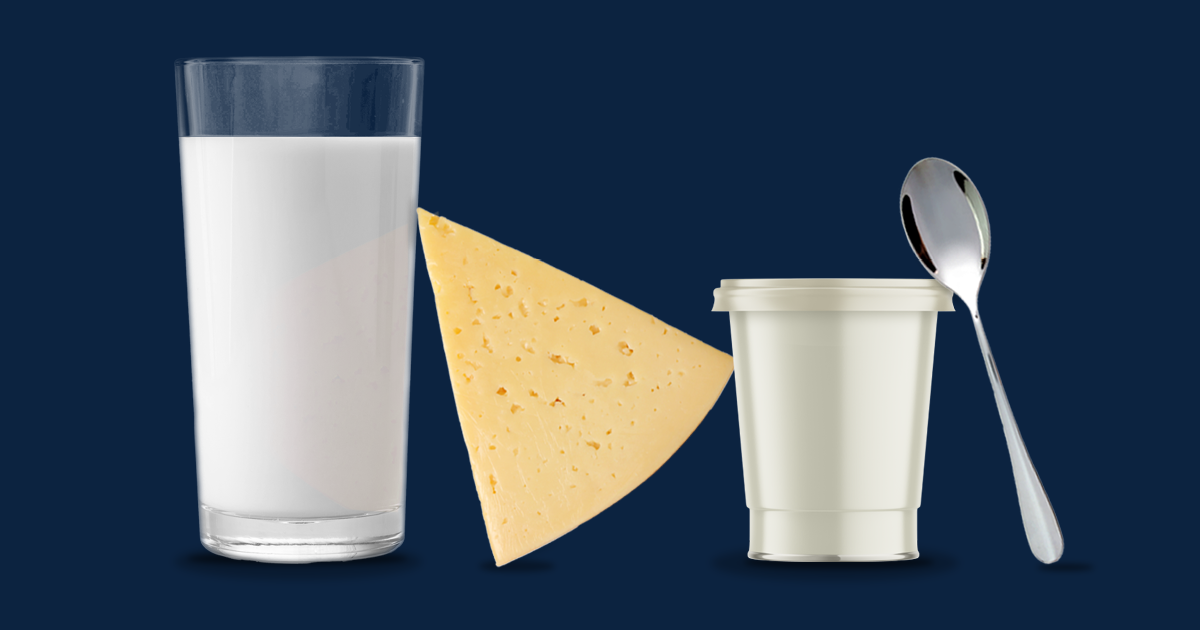
Lactose intolerance and digestive discomfort
Researchers have shown that a substantial amount of the Australian population are avoiding dairy foods and the majority are doing so due to gastrointestinal symptoms. There is a widespread tendency to self-diagnose, especially when it comes to food intolerances. Dairy foods such as milk, cheese and yoghurt can be consumed by those who have lactose intolerance. For those limiting their intake of dairy foods due to digestive problems, there are ways to ‘do dairy differently’ and avoid missing out on the health benefits.
Digestive discomfort
An increasing number of Australians report experiencing digestive problems such as bloating, abdominal pain, diarrhoea or flatulence. These symptoms may be due to a number of factors including stress, medication, inadequate exercise and food intolerances.1 Yet patients often limit or cut out dairy foods from their diet in an effort to relieve symptoms without consulting a health professional.
With nine out of ten Australians not meeting the recommended daily intake from the dairy food group,2 many people are missing out on the health benefits of dairy foods such as a reduced risk of type 2 diabetes, cardiovascular disease and hypertension.3
Research suggests there are strategies to try that ensure patients don't miss out on the benefits of dairy foods.
21-day milk-drinking intervention
Patients who have cut out dairy foods from their diet due to digestive problems can try a 21-day milk-drinking intervention.4 This involves starting with half a cup of milk with a meal twice a day in week 1, increasing this to two-thirds of a cup in week 2 and then one cup during week 3. Patients who complete the 21-day milk-drinking intervention see an improvement in symptoms and go on to enjoy milk and other dairy foods such as cheese and yoghurt as part of their everyday meals and snacks.
Do dairy differently
If a patient is limiting their intake of dairy foods due to digestive problems, they can find ways to ‘do dairy differently’. This might mean spreading their intake of dairy over the day; having dairy foods with meals; or having smaller amounts of dairy at a time to gradually build up their tolerance.
Read more about achieving Digestive Comfort and making dairy work for your patients.
Digestive discomfort resources
Fact sheet
Download the fact sheet
Infographic
Download the infographic
Dairy and lactose intolerance
Lactose intolerance is mostly a deficiency rather than an absence of the lactase enzyme, which helps break down lactose. With a diagnosis of lactose intolerance the amount of lactose that can be tolerated will vary from person to person.
When it comes to dairy foods and lactose intolerance there is some confusion in the community. Many people misunderstand ‘low lactose’ or ‘lactose free’ to mean ‘dairy free’. Yet evidence shows many people can still enjoy dairy foods even with lactose intolerance.
For people with lactose intolerance, the Australian Dietary Guidelines recommend:
- Up to 250ml of milk may be well tolerated if consumed with other foods or if intake is spread throughout the day.
- Most hard cheeses are virtually lactose free.
- Yoghurt contains ‘good’ bacteria that help to digest lactose.
- Lactose free milks are available and contain similar nutrients to regular milk.
Lactose intolerance resources
Fact sheets
Download the fact sheet
Lactose Intolerance fact sheet
White paper
This white paper by Nutrition Epidemiologist, Dr Malcolm Riley and Senior Research Scientist & Dietitian, Dr Jane Bowen from the CSIRO, reviews the latest in lactose intolerance research.
Download the white paper
Infographic
“What is the difference between lactose maldigestion and lactose intolerance?” If you have ever been asked this question, our infographic can help explain.
Download the infographic
Expert interviews
Professor Dennis Savaiano from Purdue University is a leading US expert on lactose digestion. Having studied lactose digestion for over 30 years he has influenced dietary recommendations relating to lactose around the world, including the 2013 Australian Dietary Guidelines.
1 Bolin, TD and The Gut Foundation. Understanding Gas and Bloating. Randwick, NSW: Digestive Diseases Research, 2011.
2 Australian Bureau of Statistics. 4364.0.55.012 - Australian Health Survey: Consumption of Food Groups from the Australian Dietary Guidelines, 2011-12. 2016.Available from: http://www.abs.gov.au/ausstats/abs@.nsf/Lookup/by%20Subject/4364.0.55.012~2011
3 National Health and Medical Research Council. Australian Dietary Guidelines, Canberra: Commonwealth of Australia; 2013.Available from: https://www.eatforhealth.gov.au/
4 O’Connor L, Eaton T, Savaiano D. Improving Milk Intake in Milk-Averse Lactose Digesters and Maldigesters. Journal of Nutrition Education and Behaviour. 2015;47(4):325-330.e1.

